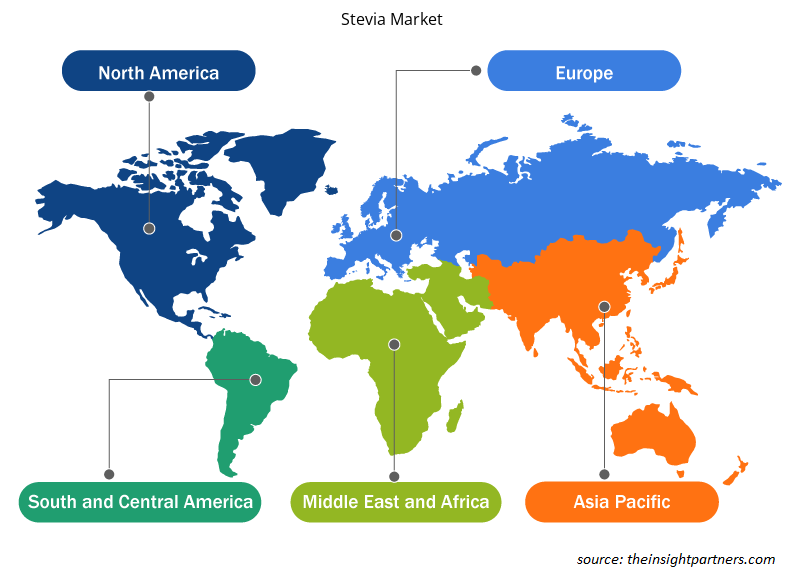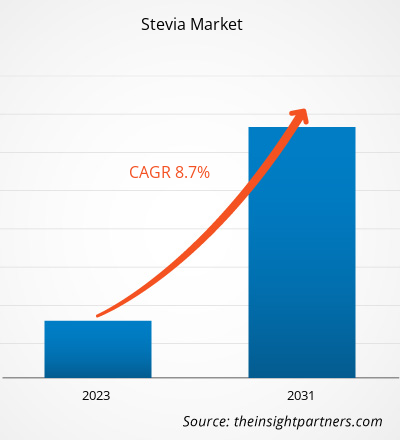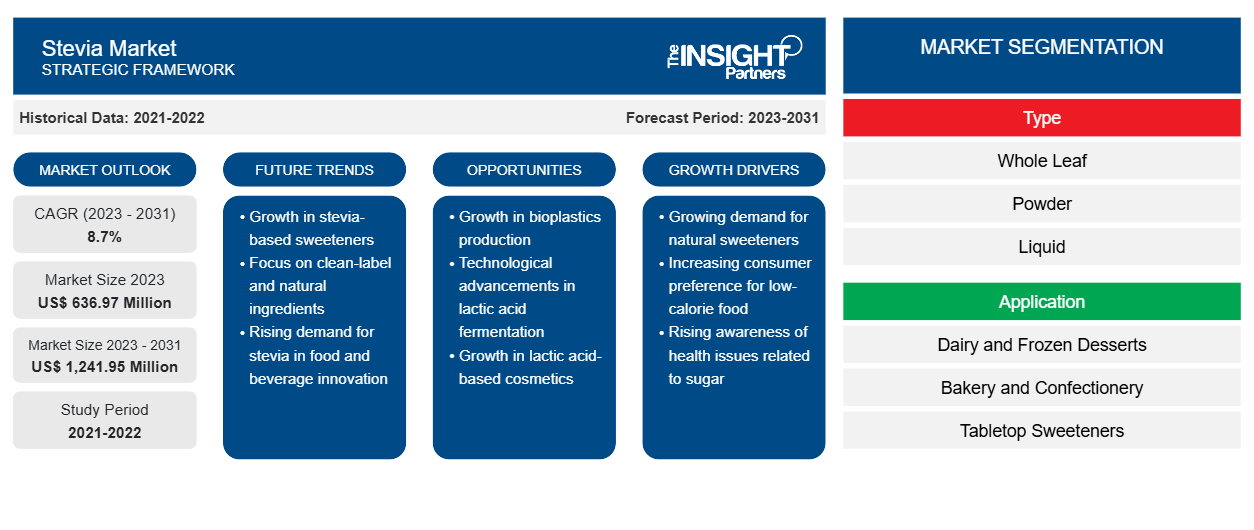Se proyecta que el tamaño del mercado de la stevia alcance los 1.241,95 millones de dólares estadounidenses en 2031, frente a los 636,97 millones de dólares estadounidenses en 2023. Se espera que el mercado registre una CAGR del 8,7 % durante el período 2023-2031. Es probable que la tendencia al alza de las alternativas al azúcar bajas en calorías, junto con una mayor conciencia de las calorías, siga siendo una tendencia clave en el mercado.
Análisis del mercado de la stevia
La creciente conciencia sobre la dieta saludable y el aumento de la conciencia de la salud entre las personas son los principales impulsores del mercado de la stevia en el mundo. Países como EE. UU., Alemania, Reino Unido, Canadá, China, Japón y Corea del Sur son los principales contribuyentes al crecimiento del mercado en el mundo. Los consumidores buscan etiquetas similares e ingredientes naturales a medida que se vuelven más conscientes de su propia nutrición. Además, la mayor conciencia de la obesidad, el control del peso y la importancia de comer una dieta saludable está impulsando la demanda de productos a base de stevia en todo el mundo. El mercado global de stevia ha estado aumentando debido a los avances en la industria de alimentos y bebidas. La industria de alimentos y bebidas es el campo de fabricación más grande en los países del mundo. El aumento del consumo de alimentos procesados entre los consumidores debido al estilo de vida ajetreado y la conveniencia está impulsando el crecimiento del mercado de stevia.
Panorama del mercado de la stevia
El aumento de la inclinación de los consumidores hacia los edulcorantes naturales ha impulsado el crecimiento del mercado mundial de la stevia. Con la creciente incidencia de la diabetes y la obesidad en todo el mundo, los consumidores están cambiando progresivamente hacia los productos edulcorantes naturales. Según la Fundación Internacional de Diabetes, 641 millones de personas tendrán diabetes en 2040, frente a los 415 millones de 2015. La obesidad es una enfermedad prevalente que conduce a la diabetes junto con otras enfermedades crónicas como la hipertensión, el síndrome metabólico, el riesgo cardiovascular y la retinopatía. Las autoridades de todo el mundo se están centrando en un estilo de vida más saludable, que incluye una reducción en la cantidad de calorías consumidas, especialmente el azúcar añadido. La Organización Mundial de la Salud (OMS) ha recomendado una disminución de los azúcares añadidos en el estilo de vida diario. Para reducir la cantidad de ingesta de azúcar, los consumidores prefieren edulcorantes naturales como la stevia, que ayuda a controlar el peso al reducir el azúcar añadido y las calorías. Junto con esto, en Europa, los consumidores consumen cada vez más productos que no tienen azúcar añadido. Según la encuesta New Nutrition Business de 2020, dos tercios de los consumidores europeos están intentando reducir su consumo de azúcar debido a la creciente tasa de obesidad y diabetes, lo que ha provocado una mayor demanda de stevia en Europa. Por tanto, el aumento de la inclinación de los consumidores hacia los edulcorantes naturales está impulsando el crecimiento del mercado de la stevia.
Personalice este informe según sus necesidades
Obtendrá personalización en cualquier informe, sin cargo, incluidas partes de este informe o análisis a nivel de país, paquete de datos de Excel, así como también grandes ofertas y descuentos para empresas emergentes y universidades.
-
Obtenga las principales tendencias clave del mercado de este informe.Esta muestra GRATUITA incluirá análisis de datos, desde tendencias del mercado hasta estimaciones y pronósticos.
Factores impulsores y oportunidades del mercado de la stevia
La creciente preocupación por la diabetes y la obesidad favorece al mercado
Con la creciente incidencia de la diabetes y la obesidad en todo el mundo, los consumidores están cambiando progresivamente hacia los productos edulcorantes naturales. Según la Fundación Internacional de Diabetes, 641 millones de personas tendrán diabetes en 2040, frente a los 415 millones de 2015. La obesidad es una enfermedad prevalente que conduce a la diabetes junto con otras enfermedades crónicas como la hipertensión, el síndrome metabólico, el riesgo cardiovascular y la retinopatía. Las autoridades de todo el mundo se están centrando en un estilo de vida más saludable, que incluye una reducción de la cantidad de calorías consumidas, especialmente el azúcar añadido. La Organización Mundial de la Salud (OMS) ha recomendado una disminución de los azúcares añadidos en el estilo de vida diario. Para reducir la cantidad de ingesta de azúcar, los consumidores prefieren edulcorantes naturales como la stevia, que ayuda a controlar el peso al reducir el azúcar añadido y las calorías. Junto con esto, en Europa, los consumidores consumen cada vez más productos sin azúcar añadido. Según la encuesta New Nutrition Business de 2020, dos tercios de los consumidores europeos están tratando de reducir su consumo de azúcar debido a la creciente tasa de obesidad y diabetes, lo que ha provocado una mayor demanda de stevia en Europa. Por lo tanto, un aumento en la inclinación de los consumidores hacia los edulcorantes naturales está impulsando el crecimiento del mercado de la stevia.
Demanda creciente de edulcorantes bajos en calorías en alimentos y bebidas
Las empresas están tomando conciencia de la stevia; Pepsi y Coca-Cola, por ejemplo, han comenzado a utilizar stevia en sus refrescos como edulcorante. La stevia también es utilizada por otros productores de productos alimenticios y bebidas, como yogures, caramelos y alimentos procesados como el kétchup. Las oportunidades en el mercado también aumentan gracias a los avances en el etiquetado de la stevia. La nueva actualización del etiquetado de la UE, que cambia el nombre del producto de "glicósidos de esteviol (E 960)" a "glicósidos de esteviol a partir de stevia (E 960)", ofrece a los consumidores una mayor transparencia e información sobre el origen botánico del producto. Se prevé que la demanda de los consumidores se vea afectada por el cambio. Según el Ingredient Tracker de Cargill, aproximadamente el 25% de los consumidores europeos conocen la frase "glicósidos de esteviol", mientras que el 64% están familiarizados con "stevia". Sin embargo, como los consumidores prestan más atención a los ingredientes utilizados en alimentos y bebidas procesados, se proyecta que el conocimiento sobre el término “glicósidos de esteviol” aumentará con el tiempo, lo que se espera que abra nuevas oportunidades en los próximos años.
Análisis de segmentación del informe de mercado de stevia
Los segmentos clave que contribuyeron a la derivación del análisis del mercado de stevia son el tipo y la aplicación.
- Según el tipo, el mercado de la stevia se divide en hojas enteras, polvo y líquido. El segmento de polvo tuvo la mayor participación de mercado en 2023. El polvo blanco de stevia es un sustituto natural y saludable del azúcar. Las hojas de stevia se secan para formar el polvo y la forma en polvo de stevia está cargada con extractos de hojas de stevia y eritritol.
- En términos de aplicación, el mercado está segmentado en productos lácteos y postres helados, panadería y confitería, edulcorantes de mesa, bebidas y otros. El segmento de productos lácteos y postres helados tuvo una participación significativa del mercado en 2023. Se espera que la creciente demanda de edulcorantes bajos en calorías en helados, yogures, batidos y otros productos lácteos debido a la creciente conciencia de las calorías y la creciente preferencia por productos con afirmaciones de "sin azúcar añadido" impulse la demanda de stevia en productos lácteos y postres helados, impulsando el crecimiento del segmento.
Análisis de la cuota de mercado de la stevia por geografía
El alcance geográfico del informe del mercado de stevia se divide principalmente en cinco regiones: América del Norte, Asia Pacífico, Europa, Medio Oriente y África, y América del Sur y Central.
La región de Asia Pacífico ha dominado el mercado. En ella, los consumidores, los expertos en salud y los gobiernos se han preocupado más por la salud y la dieta. Esto ha llevado a que los distintos fabricantes de alimentos y bebidas adopten edulcorantes naturales, incluida la stevia. La stevia es un edulcorante de origen vegetal que funciona bien en diversas aplicaciones de alimentos y bebidas. Con la creciente importancia del edulcorante stevia, su uso también ha aumentado en bebidas gaseosas, helados, productos horneados, aguas saborizadas y con gas, tés y cafés listos para beber, leches saborizadas, edulcorantes de mesa y otros productos alimenticios y bebidas en la región. Las distintas políticas gubernamentales también contribuyen al crecimiento del mercado de la stevia en la región. Por ejemplo, el Ministerio de Salud de Singapur (MOH) recomendó varias políticas que podrían tener un impacto en las industrias de alimentos y bebidas, incluida la prohibición de la venta de bebidas preenvasadas con alto contenido de azúcar y la imposición de un impuesto a las bebidas azucaradas.
Perspectivas regionales del mercado de la stevia
Los analistas de Insight Partners explicaron en detalle las tendencias y los factores regionales que influyen en el mercado de la stevia durante el período de pronóstico. En esta sección también se analizan los segmentos y la geografía del mercado de la stevia en América del Norte, Europa, Asia Pacífico, Oriente Medio y África, y América del Sur y Central.

- Obtenga los datos regionales específicos para el mercado de Stevia
Alcance del informe sobre el mercado de la stevia
| Atributo del informe | Detalles |
|---|---|
| Tamaño del mercado en 2023 | US$ 636,97 millones |
| Tamaño del mercado en 2031 | US$ 1.241,95 millones |
| CAGR global (2023 - 2031) | 8,7% |
| Datos históricos | 2021-2022 |
| Período de pronóstico | 2023-2031 |
| Segmentos cubiertos |
Por tipo
|
| Regiones y países cubiertos |
América del norte
|
| Líderes del mercado y perfiles de empresas clave |
|
Densidad de actores del mercado de stevia: comprensión de su impacto en la dinámica empresarial
El mercado de la stevia está creciendo rápidamente, impulsado por la creciente demanda de los usuarios finales debido a factores como la evolución de las preferencias de los consumidores, los avances tecnológicos y una mayor conciencia de los beneficios del producto. A medida que aumenta la demanda, las empresas amplían sus ofertas, innovan para satisfacer las necesidades de los consumidores y aprovechan las tendencias emergentes, lo que impulsa aún más el crecimiento del mercado.
La densidad de actores del mercado se refiere a la distribución de las empresas o firmas que operan dentro de un mercado o industria en particular. Indica cuántos competidores (actores del mercado) están presentes en un espacio de mercado determinado en relación con su tamaño o valor total de mercado.
Las principales empresas que operan en el mercado de Stevia son:
- Cargill, Incorporada
- Ingredion Incorporated
- Tate & Lyle PLC
- GLG CORPORACIÓN TECNOLÓGICA DE VIDA
- ADM
- Stevia Sunwin Internacional, Inc.
Descargo de responsabilidad : Las empresas enumeradas anteriormente no están clasificadas en ningún orden particular.

- Obtenga una descripción general de los principales actores clave del mercado de Stevia
Noticias y desarrollos recientes del mercado de la stevia
El mercado de la stevia se evalúa mediante la recopilación de datos cualitativos y cuantitativos a partir de investigaciones primarias y secundarias, que incluyen publicaciones corporativas importantes, datos de asociaciones y bases de datos. A continuación, se enumeran algunos de los avances en el mercado de la stevia:
- Tate & Lyle PLC (Tate & Lyle), líder mundial en soluciones de ingredientes para alimentos y bebidas más saludables, se complace en anunciar una nueva incorporación a su cartera de edulcorantes: el edulcorante de stevia TASTEVA® SOL. Esta incorporación, un avance patentado a nivel internacional en la tecnología de la stevia, amplía la capacidad de Tate & Lyle para ayudar a los clientes a resolver los problemas de solubilidad de la stevia en alimentos y bebidas y ayuda a satisfacer la demanda de los consumidores de productos más saludables y sabrosos, con menos azúcar y calorías. (Fuente: Tate and Lyle, sitio web de la empresa, julio de 2023)
- Ingredion Incorporated (NYSE: INGR), un proveedor líder mundial de ingredientes especiales para la industria de alimentos y bebidas, anuncia la expansión de PureCircle™ de la planta de producción de stevia de Ingredion en Malasia, lo que amplía aún más su posición como el operador a mayor escala de ingredientes de stevia de bioconversión. Esta expansión aumenta la capacidad de tecnología de bioconversión de PureCircle, lo que permite cuadriplicar la capacidad actual para estos ingredientes. La inversión aumenta significativamente la escala y el suministro de los ingredientes de hoja de stevia de mejor sabor para reemplazar el azúcar y los edulcorantes artificiales en las categorías de alimentos y bebidas. (Ingredion, comunicado de prensa, noviembre de 2023)
Informe sobre el mercado de la stevia: cobertura y resultados
El informe “Tamaño y pronóstico del mercado de Stevia (2021-2031)” proporciona un análisis detallado del mercado que cubre las siguientes áreas:
- Tamaño del mercado de stevia y pronóstico a nivel global, regional y nacional para todos los segmentos clave del mercado cubiertos bajo el alcance
- Tendencias del mercado de stevia, así como dinámica del mercado, como impulsores, restricciones y oportunidades clave
- Análisis detallado de las cinco fuerzas de Porter y PEST y FODA
- Análisis del mercado de stevia que abarca las tendencias clave del mercado, el marco global y regional, los principales actores, las regulaciones y los desarrollos recientes del mercado.
- Panorama de la industria y análisis de la competencia que abarca la concentración del mercado, análisis de mapas de calor, actores destacados y desarrollos recientes para el mercado de la stevia
- Perfiles detallados de empresas
- Análisis histórico (2 años), año base, pronóstico (7 años) con CAGR
- Análisis PEST y FODA
- Tamaño del mercado, valor/volumen: global, regional y nacional
- Industria y panorama competitivo
- Conjunto de datos de Excel
Informes recientes
Testimonios
Razón para comprar
- Toma de decisiones informada
- Comprensión de la dinámica del mercado
- Análisis competitivo
- Información sobre clientes
- Pronósticos del mercado
- Mitigación de riesgos
- Planificación estratégica
- Justificación de la inversión
- Identificación de mercados emergentes
- Mejora de las estrategias de marketing
- Impulso de la eficiencia operativa
- Alineación con las tendencias regulatorias























 Obtenga una muestra gratuita para - Mercado de Stevia
Obtenga una muestra gratuita para - Mercado de Stevia